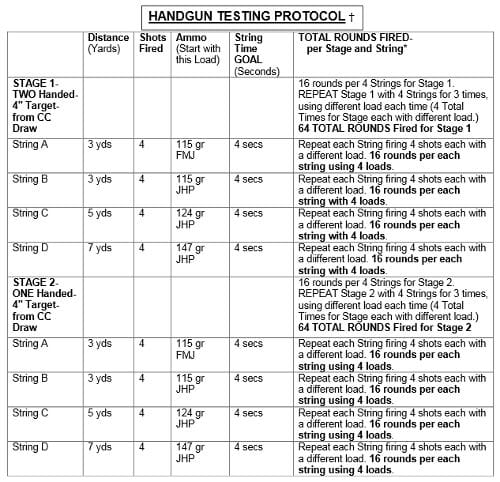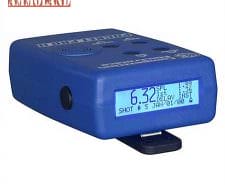By Col. Ben Findley
Author Col. Ben Findley explains his handgun testing protocol that he uses for picking his concealed carry weapons.


USA -(AmmoLand.com)- When deciding to buy a new concealed carry handgun or to field test one you already own for reliability and accuracy, it is not sufficient to just know the gun’s specifications, reputation, use, and general performance.
You should handle and shoot each of your finalist guns by using a standard set of drills or what I call a handgun testing “Protocol” to objectively evaluate them for the best choice.
You should draw and shoot the gun with various ammo types and in trials that allow you to see how it will perform in various time-sensitive situations.
Handgun Testing is especially true if you are using or planning to use the gun for concealed carry (CC).
You must experience the gun firsthand and feel comfortable with its consistent function and performance. Of course, you must do your part and be proficient with your skills and allow the gun to show its performance and worth. So, it really is a proficiency test for both you and the gun.
You need to use a reliable gun and be accurate with it at different CC distances, with ammo of various weights, and while drawing and shooting with one and two hands for precision, under time pressure, etc. and do this safely. You must intimately handle, operate the controls, load and unload it, rack the slide or eject the cartridges, try various hollow point and full metal jacket ammo in it, and draw and shoot the handgun, so you can judge it for yourself.
Of course, it is best to do this BEFORE you buy the gun. So rent the gun first if you can or borrow it from a friend. Certainly, do this BEFORE you decide on your carry gun.
After all, your life may be dependent on this gun. Decide if the gun ergonomically matches your physical characteristics, such as hand size, finger length, hand and eye dominance, and grip strength. But just because it feels good in your hand and is comfortable are not the only reasons to buy and use it to protect your life. Sure you want a gun that feels good in your hand, but first you want a gun you can count on as being consistently reliable and gets you an accurate hit on the target quickly. I want the gun to meet ALL my requirements and criteria, including comfort, accuracy and reliability, etc.

My book “Concealed Carry and Handgun Essentials” presents chapters on selecting your CC gun with detailed criteria, key considerations, and drills to help you. Given your personal physical characteristics, style, preferences, and gun features, you must primarily test the gun for accuracy and reliability in realistic drills.
Proficiency drills for your shooting skills are also drills for you to evaluate that particular gun when handgun testing. I believe that you should shoot about 200 rounds of full metal jacket ammo in a variety of weights (e.g. 115, 124, & 147 grains) of quality loads at varying prices. It is important to know the type of load that can be best digested by your carry gun without any malfunctions or stoppages. More than one malfunction or stoppage is usually NOT acceptable for any load in a CC gun with 400 rounds fired. Some say not even one is acceptable for 400-500 rounds fired in a carry gun. So pay attention and try various weights of bullets and cartridge types.
Yes, shoot some less expensive practice or training ammo through the gun to see how it handles them. But then I believe you MUST also periodically shoot the hollow point self-defense ammo that you will carry. I know it is expensive, but you have to decide the cost-benefit payoff because your life depends on your rational choice. “Bite the bullet and do it!”
So, shoot about 200 rounds of hollow point ammo also in various weights through the self-defense gun. Once you narrow down your many gun options, you must shoot your two or three gun finalists to help you assess accuracy and reliability and to make a final purchase or use decision. You must judge for yourself the guns accuracies and reliabilities. So fork over the cost of the ammo, so you don’t bet your life on unexpected outcomes with your personal protection gun. You will have the peace of mind of knowing that you can count on your gun. It will be reliable and accurate for you in stressful encounters. And I don’t mean discover this from just randomly punching holes in paper at the range. You should have your own standard procedure to test each gun (and your own proficiencies) up front.
Use the same Protocol or series of drills for each gun you are evaluating. Do you have one?
So what handgun testing and evaluation protocol or set of drills do you use for your guns?
What protocol will you use to evaluate your new handgun or for a specific use, like CC? If you have one, I would sincerely like to know your protocol, so please comment below or email me. I believe a shooter must assess accuracy and reliability for each CC gun being considered by observing the size of the shot groups at various realistic CC encounter distances, while drawing and for speed, using different shooting positions, using two hands and one hand, and with different ammo loads, drills, etc. Of course, you as the shooter must do your part with practicing and implementing the fundamentals of shooting, with attention to sight alignment, trigger control, movement control, breath control, proper grip, etc.
Also, I believe that every gun you shoot should be thoroughly cleaned BEFORE shooting it… and AFTER every range trip. It is a pain to do this, but well worth it (aside from the direct relationship between a clean gun and accuracy & reliability) if for nothing else your renewing your familiarity with the gun model, its operation and controls, and its specific features. This is in addition to the assurance you have from your hands-on maintenance of the gun, knowing its proper lubrication points, and handling it, etc. I can disassemble, lubricate, and reassemble our many guns now PROPERLY in about an average of 3-4 minutes for each gun, after much practice. Most folks can do this in less time probably. My book has a chapter that can help you with proper gun maintenance and the key lubrication points, so you will quickly know for your guns where best to place the weapons lubricant.
Below is the Handgun Testing Protocol I use for my CC pistols (and for other guns with some drill modifications.) My book also has several self-defense drills that can help you with your proficiency and for evaluating handguns, e.g. My 5-Shot Touch Group Drill and my 44 Drill.
HANDGUN TESTING PROTOCOL (Col Ben’s 44-44 CC Drill)
GOAL: Select the best CC handgun, based on shooting it for accuracy and reliability at different distances, from basic shooting-hand positions and CC draw, using different ammo loads, while timed in two Stages. ALL rounds fired must hit in the 4″ targets.
Draw and Fire in sequence 4 Consecutive 4-Shot Groups (16 rounds) in 4 Seconds each into 4″ targets (circle/index card) from each of 2 shooting positions at specified CC distances.

* To effectively evaluate & test your gun with various ammo at different distances, REPEAT Stage 1 and Stage 2 for 2 times each to shoot a Total of 256 Total Rounds Fired for both Stages. This will give a high round count to ease your mind about the gun’s reliability & accuracy. ALL rounds must hit within 4″ targets. About 200 FMJ AND 200 JHP rounds or so are optimal for complete pistol testing & evaluation.
NOTE: Both Stages do NOT have to be completed at the same range session, given necessary Total round count for thorough handgun testing and the Protocol challenges. Also, Stages do NOT have to be repeated at the same session with just one stage completed at a session, given your ammo supply. SAFETY FIRST!
STAGE 1:
String A) at 3 yards- Draw & fire 4 consecutive (start with 115 grain FMJ) rounds from a two-handed position at a 4″ target, then repeat the same at 3 more targets (total of 4 4-shot groups) using different ammo as specified below. String GOAL= Fire 4 Shots in 4 seconds.
Total = 16 Rounds:
- 4 (115 gr FMJ) rounds + 4 (115 gr JHP) rounds + 4 (124 gr JHP) + 4 (147 gr JHP)
String B) at 3 yards- Draw & fire 4 consecutive (start with 115 grain JHP) rounds from a two-handed position at a 4″ target, then repeat the same at 3 more targets (total of 44-shot groups) using different ammo as specified below. String GOAL= 4 Shots in 4 seconds.
Total = 16 Rounds:
- 4 (115 gr FMJ) rounds + 4 (115 gr JHP) rounds + 4 (124 gr JHP) + 4 (147 gr JHP)
String C) at 5 yards- Draw & fire 4 consecutive (start with 124 grain JHP) rounds from a two-handed position at a 4″ target, then repeat the same at 3 more targets (total of 4 4-shot groups) using different ammo as specified below. String GOAL= 4 Shots in 4 seconds.
Total = 16 Rounds:
- 4 (115 gr FMJ) rounds + 4 (115 gr JHP) rounds + 4 (124 gr JHP) + 4 (147 gr JHP)
String D) at 7 yards- Draw & fire 4 consecutive (start with 147 grain JHP) rounds from a two-handed position at a 4″ target, then repeat the same at 3 more targets (total of 4 4-shot groups) using different ammo as specified below. String GOAL= 4 Shots in 4 seconds.
Total = 16 Rounds:
- 4 (115 gr FMJ) rounds + 4 (115 gr JHP) rounds + 4 (124 gr JHP) + 4 (147 gr JHP)
TOTAL STAGE 1= 64 Rounds (This stage can be repeated (now or later) to fire another 64 rounds to add to the total rounds fired to better evaluate your gun with 128 rounds fired this Stage.)
STAGE 2:
String A) at 3 yards- Draw & fire 4 consecutive (start with 115 grain FMJ) rounds from a one-handed position at a 4″ target, then repeat the same at 3 more targets (total of 4 4-shot groups) using different ammo as specified below. String GOAL= 4 Shots in 4 seconds.
Total = 16 Rounds:
- 4 (115 gr FMJ) rounds + 4 (115 gr JHP) rounds + 4 (124 gr JHP) + 4 (147 gr JHP)
String B) at 3 yards- Draw & fire 4 consecutive (start with 115 grain JHP) rounds from a one-handed position at a 4″ target, then repeat the same at 3 more targets (total of 4 4-shot groups) using different ammo as specified below. String GOAL= 4 Shots in 4 seconds.
Total = 16 Rounds:
- 4 (115 gr FMJ) rounds + 4 (115 gr JHP) rounds + 4 (124 gr JHP) + 4 (147 gr JHP)
String C) at 5 yards- Draw & fire 4 consecutive (start with 124 grain JHP) rounds from a one-handed position at a 4″ target, then repeat the same at 3 more targets (total of 4 4-shot groups) using different ammo as specified below. String GOAL= 4 Shots in 4 seconds.
Total = 16 Rounds:
- 4 (115 gr FMJ) rounds + 4 (115 gr JHP) rounds + 4 (124 gr JHP) + 4 (147 gr JHP)
String D) at 7 yards- Draw & fire 4 consecutive (start with 147 grain JHP) rounds from a one-handed position at a 4″ target, then repeat the same at 3 more targets (total of 4 4-shot groups) using different ammo as specified below. String GOAL= 4 Shots in 4 seconds.
Total = 16 Rounds:
- 4 (115 gr FMJ) rounds + 4 (115 gr JHP) rounds + 4 (124 gr JHP) + 4 (147 gr JHP)
TOTAL STAGE 2= 64 Rounds (This stage can be repeated (now or later) to fire another 64 rounds to add to the total rounds fired to better evaluate your gun with 128 rounds fired this Stage.)
TOTAL ROUNDS FIRED- Stage 1 and Stage 2 = 128 Rounds (see Note #3 below.)
POSITIONS: Shoot from 2 Shooting Positions:
- a) Standing Two-Handed- draw from CC garment
- b) Standing One-Handed- draw from CC garment
AMMO: Use 4 different Ammo Loads:
- a) 115 gr FMJ- 24 rounds total @ 3 distances
- b) 115 gr JHP- 24 rounds total @ 3 distances
- c) 124 gr JHP- 24 rounds total @ 3 distances
- d) 147 gr JHP- 24 rounds total @ 3 distances
TOTAL ROUNDS FIRED -all Loads Stages 1 and 2 = 128 Rounds
Gear & Accessories Required for Proper Handgun Testing:
- 1) Concealed Carry (CC) handgun with at least 3 mags
- 2) CC holster and CC mag pouch
- 3) CC belt
- 4) CC garment
- 5) Total of 150 Rounds of Ammo minimum (of specified loads) – double that is suggested.

If Stages 1 and 2 (with 128 total rounds) are repeated for a total of 256 total rounds (using both FMJ and JHP rounds) fired to fully evaluate your gun.
- 6) Shot Timer
NOTES:
- 1) SAFETY First Always! Be very careful drawing and firing your pistol. Do not attempt this protocol unless you are proficient with a handgun and practice regularly. Modify it to match your abilities.
- 2) Do NOT time yourself initially. Go SLOW at first. Accuracy first with all hits on each target. Speed can come later when you become more proficient and confident in handling your gun.
- 3) If more shooting time is needed to evaluate each gun tested, double the number of the 4 loads (FMJ and JHP) used, so you would shoot 256 rounds total a gun (or triple the number of each load used for 384 rounds used a gun.) This can be done over a few months before making your CC gun decision.
- 4) For more challenge, use a 3×5 inch card for a head target and make the last shot a head shot in each of the 4 consecutive shots in each string. Also, you can shoot it with your support-hand only. My experience is that most can initially accomplish Strings A, B, and C at 3 and 5 yards in both Stages, but that it takes more time and focus to accomplish String D at 7 yards in both. All of these distances are realistic concealed carry encounter distances. Don’t rush it and be deliberate and Safe.
Continued Success and Be Safe!
Photos by Author.
Thanks to Sig Sauer for supplying the various Sig Sauer Elite Performance ammo loads for my handgun testing Protocol.
* This personal opinion article is meant for general information & educational purposes only and the author strongly recommends that you seek counsel from an attorney for legal advice and your own personal certified weapons trainer for proper guidance about shooting & using YOUR firearms, self-defense and concealed carry. It should not be relied upon as accurate for all shooters & the author assumes no responsibility for anyone’s use of the information and shall not be liable for any improper or incorrect use of the information or any damages or injuries incurred whatsoever.
© 2016 Col Benjamin Findley. All Rights Reserved. This article may not be reprinted or reproduced in whole or in part by mechanical means, photocopying, electronic reproduction, scanning, or any other means without prior written permission. For copyright information, contact Col Ben Findley at ColBFF@gmail.com.
Col Ben’s Handgun Testing Protocol is copyright with All Rights Reserved.

About Ben Findley:
“Col Ben” is retired with 30 years service in the U.S. Air Force, with joint services Special Ops duty and training, and is Air Force qualified as “Expert” in small arms. Ben is an experienced NRA-Certified Pistol Instructor, NRA Range Safety Officer, and FL Concealed Carry License Instructor. Ben recently wrote the book “Concealed Carry and Handgun Essentials for Personal Protection” with 57 comprehensive Chapters about concealed carry and handgun principles, techniques, and tips for both experienced and new shooters. His reference book is endorsed by several organizations and is available on his website at www.FloridaHandgunsTraining.com. Contact him at ColBFF@gmail.com.
